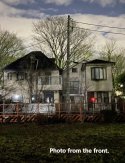Hi Steve, thanks for listening to the podcast

RE: the land grab motive theory. Put simply, there is very little for it and a mountain of reasons standing against it. First and foremost, the Miyazawas had already agreed to sell up. So that, right there, immediately cuts this theory down. But then let's consider the scenario. There were four houses (of the original 200) that were still occupied, including Ann and the family next door. So, why did only the Miyazawas die? Would the developer somehow hope that their sushi-knife assassin was going to take out everyone in the housing complex? It doesn't pass the smell test. Also, for some reason, people always refer to some nebulous developer -- it was the City of Tokyo that was buying the land back in order to expand the park. Not some cut-throat bubble economy outfit. Sure, they may have been third parties in between and the construction gig is notoriously fertile ground for mafia, but how would any of that connect to a killer as young as 15 (according to the TMPD, not me) murdering kids with a sushi knife? Lastly, the City now owns the house itself. Ann, I believe, inherited the property and then sold up. So, all of that to say, if the motive behind these murders was to get that land and the Miyazawas were standing in the way, would this be mission accomplished? It seems not, given the house is still standing 23 years later and, I would imagine, nobody involved in that expansion project is still around.
As for demolishing the house, the supposed reason is for safety. It's going to fall down sooner or later given how seismic Japan is. I suspect the secret reason is that it's a shameful reminder. I can't speak to crime scenes being preserved in this way. As per one of my recent posts, I know that one particular apartment where a man's wife and child were murdered is still kept by him, he pays the rent and so on, waiting for the day that DNA laws change. But no, I've never heard of a house being kept like this.
So, I would disagree about the significance of the house itself. The very premise requires a materially-driven motive. So, that is to say, money. And when you consider Yasuko was left *without a face*, when you consider Niina's front teeth were knocked out, when you consider the killer sliced open his own hand while stabbing Mikio in the head and yet, he did not flee, but simply switched to his left -- put all of that together and I think the driver is far more visceral than money. It's a total guess of course and while I know this case inside out, my guess is no better than anyone else's when you boil it down... But I see rage in these murders. Or hatred.





